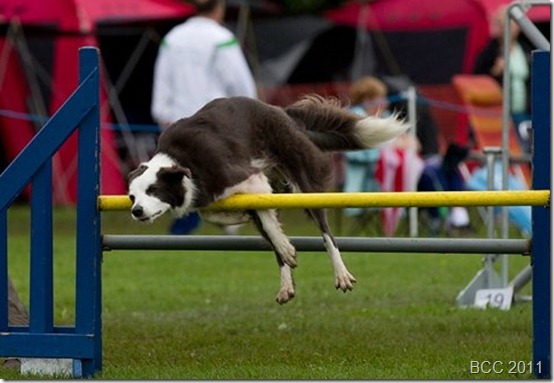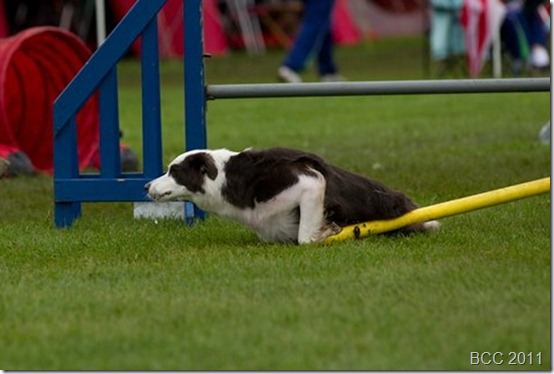Agility Related Injuries
In November I gave a lecture at DCH on agility related injuries. I focused on those minor injuries that might not manifest as a problem at first, but may lead to reduced performance.
Note: The pictures in this blog post are to illustrate the crashing of a jump and the impact upon landing only! The crash was caused by a very slippery surface - not bad execution of handling. The featured dog is Lady owned by my friend Channie. Lady is fully up to date on physical treatments etc.
I hope I didn't scare to many by pointing out how easily our dogs can get minor injuries due to handling or equipment, but I think I is important to be aware of how badly timed execution of handling can affect the dog and lead to injuries.
For example if you cue a turn after take-off the dog might try to respond to that cue and compensate which might have a severe impact on the dogs shoulders upon landing. A dropped bar might be another result. Not that a drop bar is an injury, but hitting the bar especially at speed hurts. If you´'ve ever crashed into a jump, you know what I am talking of.
I am a big fan of rubberized contact equipment - no surprise there. But not just any kind for rubber as a thin layer will provide a better grip for the dog, but in my opinion it has to be tick enough to be shock absorbent as well. Whether or not the slats works in favor of the dog is debatable. FCI requires them, and therefor you don't see equipment without them in Europe. The slats are prone to cause toe injuries, though. When accidentally hitting the slats it might cause a hyperflextion or hyperextension of the toe. It can cause a mild strain, but if the impact is severe enough it might result in a ligament rupture or a fracture. A strained toe might cause a subtle or on/off limb, that only a trained eye will detect, but might manifest it self in a more obvious way by leading to the dog not running as fast as it used to or turning as tight as before.
The break-away tire is to me one of the best inventions ever! The old none break-away type has been know to cause severe hip and back injuries. I am extremely happy that the break-away tire is mandatory in Denmark.
Chiropractic treatments has for years been part of my dogs conditioning program. Running agility puts a lot of stress on the dog's body. You don't run agility to condition your dog, you condition your dog to be able run agility. It is our responsibility to make sure our dogs are fit and up of the task. So if you detect a difference in your dogs performance, you might want to consider scheduling an appointment with a skilled chiropractor. My dogs gets a chiropractic check up every other month. This is prophylactic as I like to get minor things, tight muscles and so, mended before they might manifest as a problem for the dog.
When I teach jumping skills and motivational classes the present health of the dog is always on top of my list. How would you feel about jumping or running at full speed if your back hurts? One thing is for sure; I would not run at full speed.
So how do you detect subtle injuries? That depends on the location of the injury and the nature of your dog, but here's a list of things to look for:
- Altered gait; stiff gait, shortened length of stride etc.
Any deviation from a normal gait is clinically classified as a limp* - Reduced performance
- Reluctant to jump
- Reluctant to turn to one side or consistently turning wider to one or both sides
- Knocking bars - especially dogs that usually stay clear of them
- Trouble stopping in 2on2off position i.e. creeping down the A-frame or missing the contact entirely
- Any sudden change is normal behavior
* There is various degrees and schemes to classify a limp. A limp can vary from a small shortened stride only noticeable at a walk to a none weight barring limp.
Fortunately many are aware of how important it is to take well care of an agility dog, but those are mainly handlers who has been training dogs for many years. Their dogs are in good shape and has a solid foundation training and therefor posses technical skills that allows them to compensate accordingly when needed. My point being chiropractic treatments and physiotherapy are not only for those dogs competing at a high level, but any dog training agility also the family pets that only goes to class once a week. Those dogs are often more likely to get severe injuries.
We want our dogs to run faster, turn tighter and respond to our handling instantly. Our high demands requires us to view our beloved pets as canine athletes. Athletes requires, besides from a specific skill set, physical conditioning, a balanced diet, physical treatments (usually a whole team chiropractors, physical therapists etc.) to perform their outmost best.
I know of many who finds it silly to spend hours on core training and lots of money on physical treatments - it's just dogs running a bit of agility they often say. All I'm saying is just make sure your demands performance-wise equals how much effort you are willing to put in to conditioning. Anything else would be unfair for the dog.
Take good care of your dog whether you have fun at class once a week or compete every weekend!


